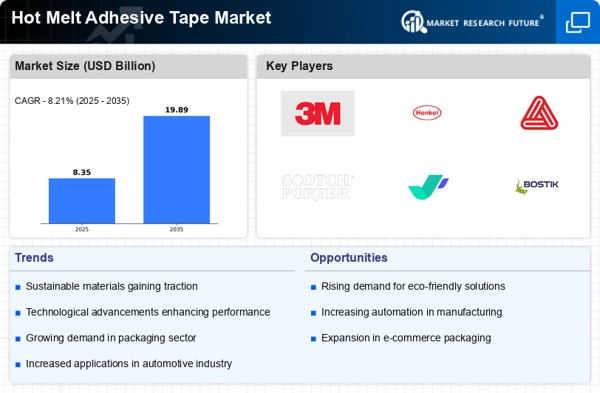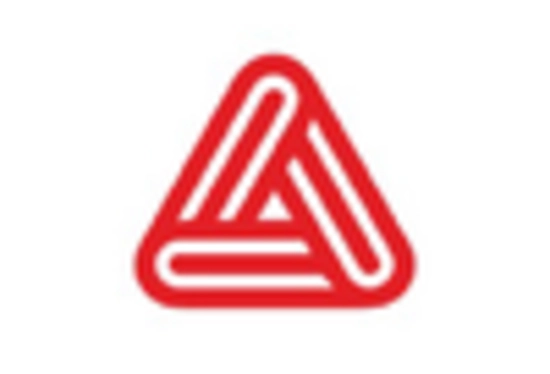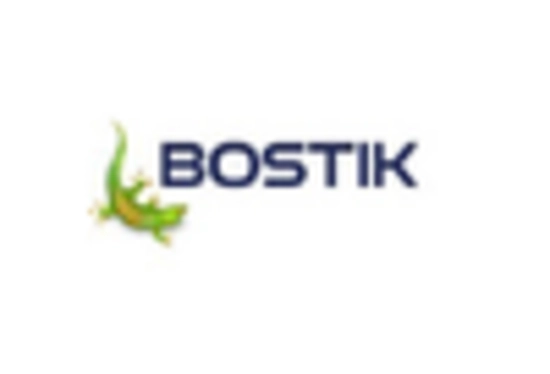The Hot Melt Adhesive Tape Market is currently characterized by a dynamic competitive landscape, driven by innovation, sustainability, and strategic partnerships. Key players such as 3M (US), Henkel (DE), and Avery Dennison (US) are at the forefront, each employing distinct strategies to enhance their market positioning. 3M (US) emphasizes innovation in product development, focusing on high-performance adhesives that cater to diverse industrial applications. Henkel (DE), on the other hand, is leveraging its extensive The Hot Melt Adhesive Tape share through strategic acquisitions and partnerships, particularly in emerging markets. Avery Dennison (US) is concentrating on sustainability, developing eco-friendly adhesive solutions that align with growing environmental concerns, thereby appealing to a broader customer base. Collectively, these strategies not only enhance individual company profiles but also intensify competition within the market, as firms strive to differentiate themselves through unique value propositions.
In terms of business tactics, companies are increasingly localizing manufacturing to reduce lead times and optimize supply chains. This approach is particularly evident in regions experiencing rapid industrial growth, where proximity to customers can significantly enhance service delivery. The competitive structure of the Hot Melt Adhesive Tape Market appears moderately fragmented, with several key players holding substantial market shares while numerous smaller firms contribute to the overall diversity of offerings. This fragmentation allows for a variety of products and innovations, fostering a competitive environment that encourages continuous improvement and adaptation.
In August 2025, 3M (US) announced the launch of a new line of hot melt adhesive tapes specifically designed for the automotive industry, which is expected to enhance vehicle assembly efficiency. This strategic move underscores 3M's commitment to innovation and its focus on high-growth sectors, potentially positioning the company as a leader in automotive adhesive solutions. The introduction of these specialized products may not only strengthen 3M's market presence but also set new performance benchmarks within the industry.
In September 2025, Henkel (DE) completed the acquisition of a regional adhesive manufacturer in Southeast Asia, a move aimed at bolstering its production capabilities and expanding its market reach in this rapidly growing region. This acquisition is strategically significant as it allows Henkel to tap into local expertise and customer preferences, thereby enhancing its competitive edge in a market that is increasingly demanding localized solutions. Such strategic expansions are likely to yield long-term benefits, reinforcing Henkel's position as a key player in The Hot Melt Adhesive Tape.
In October 2025, Avery Dennison (US) launched a new sustainability initiative aimed at reducing the carbon footprint of its adhesive products by 30% over the next five years. This initiative reflects a broader industry trend towards sustainability, as companies recognize the importance of environmentally friendly practices in attracting customers and meeting regulatory requirements. By prioritizing sustainability, Avery Dennison not only enhances its brand reputation but also aligns itself with the growing consumer demand for eco-conscious products, potentially driving future growth.
As of October 2025, the competitive trends within the Hot Melt Adhesive Tape Market are increasingly influenced by digitalization, sustainability, and the integration of advanced technologies such as AI. Strategic alliances are becoming more prevalent, as companies seek to leverage complementary strengths to enhance their market offerings. The shift from price-based competition to a focus on innovation, technology, and supply chain reliability is evident, suggesting that future competitive differentiation will hinge on the ability to deliver unique, high-quality products that meet evolving customer needs.

















Leave a Comment